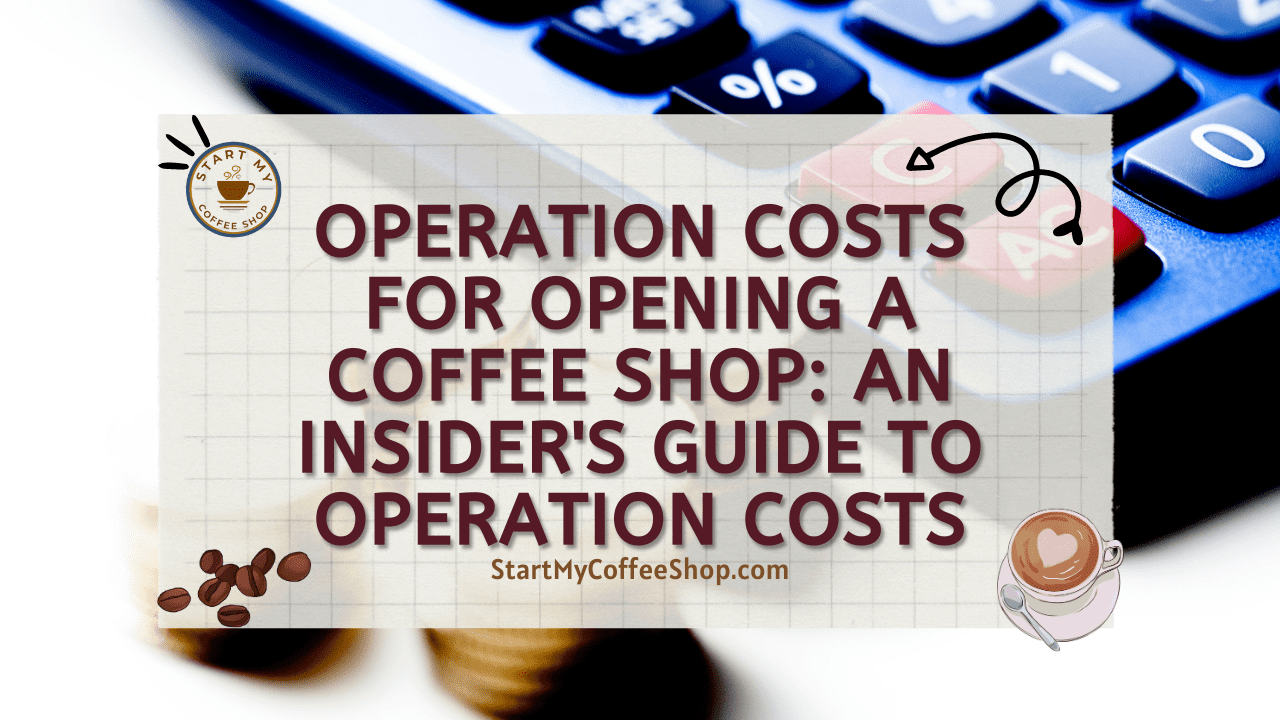Opening a coffee shop is a dream come true for many aspiring entrepreneurs and coffee enthusiasts. However, behind the aroma of freshly brewed coffee lies the reality of careful financial planning.
The key factors and estimated operation costs for opening and running a coffee shop include location, rent, equipment, staff wages, supplies, marketing, licenses, permits, and utilities.
In this article, I will delve into the key factors and estimated operation costs involved in opening and running a great coffee shop.
Location
 When it comes to opening a coffee shop, the location is of paramount importance. Choosing a prime location with high foot traffic can have a profound impact on the performance of your shop. It’s no secret that securing such prime real estate comes with a price tag. Rent expenses will vary depending on the city and neighborhood, but finding the right balance between visibility and affordability is crucial.
When it comes to opening a coffee shop, the location is of paramount importance. Choosing a prime location with high foot traffic can have a profound impact on the performance of your shop. It’s no secret that securing such prime real estate comes with a price tag. Rent expenses will vary depending on the city and neighborhood, but finding the right balance between visibility and affordability is crucial.
A bustling location with plenty of potential customers passing by can lead to increased visibility and greater opportunities for attracting new customers. However, such locations often come with higher rental costs. On the other hand, choosing a more affordable location might mean sacrificing some visibility or settling for a slightly quieter area. Striking a balance between these factors is key to optimizing your business’s chances of greatness while keeping your operating costs within manageable limits.
When considering potential locations, conduct thorough research and analyze the foot traffic patterns in different areas. Look for areas with a high concentration of your target demographic and consider the proximity to other complementary businesses that could drive traffic to your shop.
Additionally, take into account the local competition in each area you’re considering. While being close to competitors can be beneficial in terms of attracting coffee lovers, an oversaturated market might make it more challenging to stand out. Strike a balance that allows you to leverage the existing coffee culture while carving out a unique niche for your coffee shop.
Remember, a prime location isn’t just about the rental cost; it’s about finding a place that aligns with your business goals and offers the best potential for long-term growth and profitability. By carefully evaluating various factors and considering both the benefits and costs associated with different locations, you can make an informed decision that sets your coffee shop on the growth path.
Read more about Cost to Open Coffee Shop Average: From Concept to Cash Register
Investing in Equipment
 After carefully selecting a suitable location, it’s time to focus on the essential component of any coffee shop: the equipment. Investing in high-quality equipment is paramount to guarantee the smooth operation of your coffee shop for years to come. From espresso machines and grinders to coffee brewers and refrigerators, the upfront cost of acquiring this equipment can be significant.
After carefully selecting a suitable location, it’s time to focus on the essential component of any coffee shop: the equipment. Investing in high-quality equipment is paramount to guarantee the smooth operation of your coffee shop for years to come. From espresso machines and grinders to coffee brewers and refrigerators, the upfront cost of acquiring this equipment can be significant.
When it comes to espresso machines, it’s wise to choose reputable brands known for their durability and reliability. These machines are the workhorses of your coffee shop, responsible for crafting the perfect espresso shots that will delight your customers’ taste buds. Investing in a reliable espresso machine will ensure consistent quality and minimize downtime due to repairs or maintenance.
Grinders are equally important, as freshly ground coffee is the foundation of a great cup. Look for grinders that offer precise and consistent grinding settings, allowing your baristas to extract the full flavor potential from your coffee beans.
Coffee brewers, such as drip machines or pour-over stations, are vital for serving various types of coffee to cater to different preferences. Consider the brewing capacity, speed, and versatility of the equipment to meet the demands of your customer base.
Refrigerators play a crucial role in storing perishable items like milk and other ingredients. Opt for energy-efficient models that provide adequate storage space and temperature control, ensuring the freshness and safety of your supplies.
While investing in quality equipment might come with a higher initial cost, it is a worthwhile investment in the long run. Reliable equipment reduces the risk of breakdowns, repairs, and replacements, which can disrupt your business operations and incur additional expenses.
Additionally, maintaining a regular maintenance schedule for your equipment is essential. Proper cleaning and servicing will extend their lifespan and ensure optimal performance, saving you money on costly repairs or premature replacements.
Ultimately, investing in top-notch coffee shop equipment sets the foundation for delivering exceptional coffee and customer experiences. The upfront cost may seem substantial, but the long-term benefits and durability outweigh the initial investment.
Staff Wages and Training
 Your baristas play a pivotal role as the face of your coffee shop. They are the ones who interact directly with customers, crafting their beverages and creating a warm and welcoming atmosphere. Investing in skilled and passionate staff is not only vital but also a crucial aspect of your operating costs.
Your baristas play a pivotal role as the face of your coffee shop. They are the ones who interact directly with customers, crafting their beverages and creating a warm and welcoming atmosphere. Investing in skilled and passionate staff is not only vital but also a crucial aspect of your operating costs.
Allocating a significant portion of your budget to staff wages is necessary to attract and retain talented baristas. Paying competitive wages not only shows your appreciation for their skills and dedication but also motivates them to deliver exceptional customer service. Remember, happy and well-compensated employees are more likely to go the extra mile to ensure customer satisfaction.
In addition to competitive wages, providing ongoing training is essential to maintain consistent coffee quality and customer service standards. As the coffee industry evolves, new brewing techniques, flavor profiles, and trends emerge. Keeping your baristas updated and well-informed ensures that they can offer the best coffee experience to your customers.
Training programs should cover various aspects, including coffee brewing techniques, latte art, flavor profiles of different coffee beans, customer service, and maintaining a clean and organized workspace. Ongoing training not only enhances the skills of your baristas but also fosters a sense of pride and professionalism among your staff.
Moreover, investing in your baristas’ professional development creates a positive work culture and employee loyalty. Consider supporting them in attending workshops, coffee competitions, or industry events. These opportunities not only expand their knowledge and skills but also expose them to the wider coffee community, inspiring creativity and innovation.
Remember, your baristas are not just employees; they are ambassadors of your brand. Their passion, knowledge, and ability to connect with customers can turn a regular cup of coffee into a memorable experience.
Supplies and Inventory
When it comes to running a coffee shop, the costs associated with supplies can quickly accumulate. From coffee beans and milk to cups and lids, keeping track of inventory and managing your supply chain efficiently is crucial to minimizing waste and optimizing your ordering process.
One key strategy for cost management is to closely monitor your inventory levels. Keeping a close eye on your stock allows you to identify patterns and make informed decisions about when to reorder supplies. Implementing an inventory management system or software can streamline this process, providing real-time insights into your stock levels and alerting you when it’s time to restock.
Buying in bulk from reputable suppliers can also help you negotiate better deals and reduce overall costs. Purchasing larger quantities of coffee beans, for example, can often result in discounted pricing per pound. This approach not only helps save money but also ensures a steady supply of ingredients without frequent interruptions.
However, it’s important to strike a balance when buying in bulk. While it may be cost-effective, buying excessive amounts can lead to inventory waste if the products expire or lose freshness before they can be used. Understanding your consumption patterns and setting realistic par levels for each item can help you optimize your bulk purchasing strategy.
Establishing strong relationships with reliable suppliers is another essential aspect of managing your coffee shop supplies. Work with reputable vendors who consistently deliver high-quality products on time. Building trust and rapport with your suppliers may also provide opportunities for negotiation, better pricing, or preferential terms.
Lastly, consider implementing sustainable practices to reduce waste and costs. For instance, offering reusable cups or encouraging customers to bring their own can help minimize the use of disposable cups and lids, saving both money and the environment.
Read more about Cost to Open Coffee Stand: Evaluating the Financial Commitment to a Coffee Stand
Marketing and Branding
In the fiercely competitive coffee industry, investing in marketing and branding efforts is essential to differentiate your coffee shop from the rest. Building a solid brand identity and effectively promoting your business can attract new customers and foster loyalty among existing ones. To make a lasting impression, allocate a portion of your operation costs to marketing initiatives.
First and foremost, design a captivating logo that represents your coffee shop’s personality and values. Your logo should be visually appealing, memorable, and reflective of the unique experience you offer. It will serve as the cornerstone of your brand and will be featured on signage, menus, and promotional materials.
Creating an attractive storefront is equally important. Invest in eye-catching signage, exterior lighting, and well-designed window displays to entice passersby. A visually appealing storefront can pique curiosity and draw potential customers into your coffee shop.
In today’s digital age, social media marketing plays a crucial role in reaching and engaging with your target audience. Establish a strong online presence by creating accounts on popular platforms like Instagram, Facebook, and Twitter. Regularly post high-quality photos of your coffee offerings, engage with followers, and run promotions or contests to generate excitement and attract new customers. Consider collaborating with influencers or partnering with local businesses to expand your online reach.
Budgeting for advertising campaigns and promotions is another effective way to increase brand awareness and drive foot traffic. This can include online advertising, local print media, radio spots, or even sponsoring community events. Strategic promotions, such as offering special discounts during slower hours or launching loyalty programs, can incentivize customers to choose your coffee shop over competitors.
Remember to track the effectiveness of your marketing efforts and make adjustments as needed. Analyze customer feedback, monitor engagement metrics on social media, and assess the return on investment of your advertising campaigns to fine-tune your marketing strategy over time.
Licenses and Permits
Ensuring compliance with local regulations and obtaining the necessary licenses and permits is a crucial step in operating a coffee shop. The costs associated with these legal requirements can vary significantly depending on your location and the specific type of coffee shop you plan to open. It is essential to conduct thorough research and budget accordingly for these expenses to avoid any surprises or delays.
Start by familiarizing yourself with the specific regulations and requirements set by your local government or municipality. This may include obtaining a business license, health department permits, food handling permits, and possibly a liquor license if you plan to serve alcoholic beverages. Each permit or license typically comes with its associated fees, which can vary based on the jurisdiction.
To accurately estimate the costs, reach out to the relevant government departments or agencies to obtain detailed information on the application process, associated fees, and any ongoing renewal fees. Take into account that some permits or licenses may need to be renewed annually or periodically, so be prepared for those additional expenses in your long-term budget planning.
In addition to permits and licenses, you may also need to consider other legal requirements such as zoning regulations, signage permits, and fire safety inspections. These requirements may incur additional costs and should be factored into your overall budget.
It is worth noting that working with a professional, such as a lawyer or consultant experienced in the coffee industry, can provide valuable guidance and ensure that you navigate the legal landscape effectively. They can help you understand the specific regulations, assist with the application process, and ensure that you are in full compliance with all relevant laws and regulations.
Utilities and Overhead Expenses
In addition to the various costs associated with operating a coffee shop, it’s essential to consider the ongoing expenses for utilities such as electricity, water, and internet access. These are unavoidable costs that are crucial for the smooth functioning of your business. Furthermore, you need to factor in other overhead expenses like insurance premiums and security costs to safeguard your coffee shop and its assets.
Estimating these expenses accurately is vital in setting competitive pricing for your products and services while ensuring a reasonable profit margin. By understanding and managing these overhead costs effectively, you can strike a balance between offering competitive prices to attract customers and generating enough revenue to cover your operational expenses. Regularly monitoring and optimizing utility usage, exploring cost-effective insurance options, and implementing security measures can help minimize these expenses over time.
Careful consideration of these overhead costs will enable you to make informed decisions about pricing strategies, profitability goals, and resource allocation. Striking the right balance between affordability for your customers and financial sustainability for your coffee shop is key to achieving long-term growth in the competitive market.
Contingency Fund
In the unpredictable world of running a coffee shop, it’s important to be prepared for unexpected events and emergencies that can arise at any time. Establishing a contingency fund specifically designated for such situations is a wise and prudent approach. A contingency fund serves as a safety net, providing financial stability and peace of mind as you navigate the ups and downs of your coffee shop’s operations.
This fund can be used to address unforeseen expenses like equipment breakdowns, unexpected repairs, sudden market fluctuations, or even temporary closures due to unforeseen circumstances. By setting aside a portion of your budget for this purpose, you ensure that you have the necessary resources to handle unforeseen challenges without jeopardizing the financial health of your coffee shop.
Having a contingency fund demonstrates your proactive approach to risk management and your commitment to the long-term stability of your business. It allows you to respond swiftly to unexpected events, minimizing disruptions to your operations and maintaining a positive customer experience.
Remember to regularly review and replenish your contingency fund to ensure it remains adequate for potential emergencies. Consider consulting with financial advisors or accountants to determine an appropriate amount based on your specific circumstances, taking into account factors such as the size of your coffee shop, your location, and the industry’s volatility.
Analyzing the Competition
Conducting thorough market research is essential to gain a comprehensive understanding of your competition. Analyze the offerings of nearby coffee shops, including their menu items, pricing, and target customer demographics. By studying their strengths and weaknesses, you can identify opportunities to differentiate your coffee shop and strategically position your business in the market.
This insight will help you allocate your resources effectively, whether it’s investing in unique menu items, providing exceptional customer service, or creating a distinctive ambiance. Understanding what sets your coffee shop apart from the competition allows you to tailor your marketing strategies, enhance your value proposition, and attract a loyal customer base.
By staying informed about the ever-evolving market landscape, you can adapt your offerings and continually innovate to stay ahead of the curve and ensure the long-term progress of your coffee shop.
Read more about Cost to Open Scooter’s Coffee Shop: Mapping Out the Financial Landscape
Budgeting and Financial Projections
After considering all the operation costs involved in opening a coffee shop, it is crucial to create a comprehensive budget and financial projections for the initial years of operation. This meticulous planning allows you to determine the timeframe for breaking even and forecast when profits will start rolling in.
A well-prepared budget not only provides clarity on financial aspects but also serves as a valuable tool when seeking financing from investors or lenders. It demonstrates your understanding of the business’s financial viability and showcases your commitment to responsible financial management.
By conducting thorough financial projections, you can make informed decisions, set realistic goals, and adjust your strategies as needed to ensure the long-term improvement and sustainability of your coffee shop.
Negotiating with Suppliers
Building strong relationships with your suppliers is a critical aspect of managing operation costs. By cultivating these relationships, you can negotiate competitive pricing and favorable terms. Consider discussing discounts for bulk purchases or exploring the possibility of discounts for timely payments.
These small adjustments can have a substantial impact on your overall expenses in the long run. Remember, even the smallest savings can contribute to your bottom line and increase profitability. Developing mutually beneficial relationships with suppliers not only helps you secure quality products but also creates a foundation for long-term collaboration and cost-saving opportunities.
Learning from Existing Coffee Shop Owners
When venturing into the coffee shop industry, seeking advice and insights from experienced owners can be invaluable. Many of them are open to sharing their experiences, achievement, and challenges, providing you with valuable perspectives and tips. Take advantage of coffee shop owner communities, industry events, and networking opportunities to connect with these seasoned professionals.
Engaging in conversations with them can offer guidance, help you avoid common pitfalls, and provide inspiration for your coffee shop journey. By tapping into the collective wisdom of those who have already walked the path, you can gain practical knowledge and build a network of supportive mentors and peers in the coffee industry.
Summary
Opening a coffee shop requires careful financial planning and a thorough understanding of the operating costs involved. From securing the right location to investing in equipment, hiring and training staff, and marketing your brand, each aspect carries its own set of expenses. By diligently estimating these costs and implementing cost-effective strategies, you can set your coffee shop up for progress.
Remember, while operating costs are crucial, a passion for coffee and a dedication to delivering a memorable customer experience are equally important factors in the journey toward a thriving coffee shop.
Frequently Asked Questions
Question: How much does it cost to purchase coffee shop equipment?
Answer: On average, you can expect to spend several thousand dollars on espresso machines, grinders, brewers, refrigerators, and other essential equipment.
Question: What licenses and permits are required to open a coffee shop?
Answer: Common requirements may include a business license, health department permits, food handling permits, and possibly a liquor license if you plan to serve alcoholic beverages.
Question: How much should I budget for staff wages in a coffee shop?
Answer: Staff wages will depend on factors such as the number of employees, their roles, and the local labor market.
To learn more on how to start your own coffee shop checkout my startup documents here
Please note: This blog post is for educational purposes only and does not constitute legal advice. Please consult a legal expert to address your specific needs.

Hi! I’m Shawn Chun
My adventure in coffee began when I first launched my first coffee shop back in the early 2000s. I had to figure out so many things on my own and to make it worse within 2 years of opening two large corporate coffee chains moved in just blocks away from me!
As I saw smaller and even some larger coffee shops in the neighborhood slowly lose customers to these giant coffee chains and slowly close up shop, I knew that I had to start getting creative…or go out of business.
I (like you may be) knew the coffee industry well. I could make the best latte art around and the foam on my caps was the fluffiest you have ever seen. I even had the best state-of-the-art 2 group digital Nuova Simonelli machine money could buy. But I knew that these things alone would not be enough to lure customers away from the name brand established coffee shops.
Eventually, through lots of trial and error as well as perseverance and creativity I did find a way to not only survive but also thrive in the coffee/espresso industry even while those corporate coffee chains stayed put. During those years I learned to adapt and always faced new challenges. It was not always easy, however, in the end, I was the sole survivor independent coffee shop within a 10-mile radius of my location. Just two corporate coffee chains and I were left after that year. All told the corporate coffee chains took down over 15 small independent coffee shops and kiosks and I was the last one standing and thriving.
Along the years I meet others with the same passion for coffee and I quickly learned that it is not only “how good a barista is” that makes a coffee shop successful, but the business side of coffee as well.
Hence why I started this website you are on now. To provide the tools and resources for up and coming coffee shop owners to gain that vital insight and knowledge on how to start a coffee shop successfully.
Stick around, browse through my helpful blog and resources and enjoy your stay! With lots of LATTE LOVE!
Shawn






